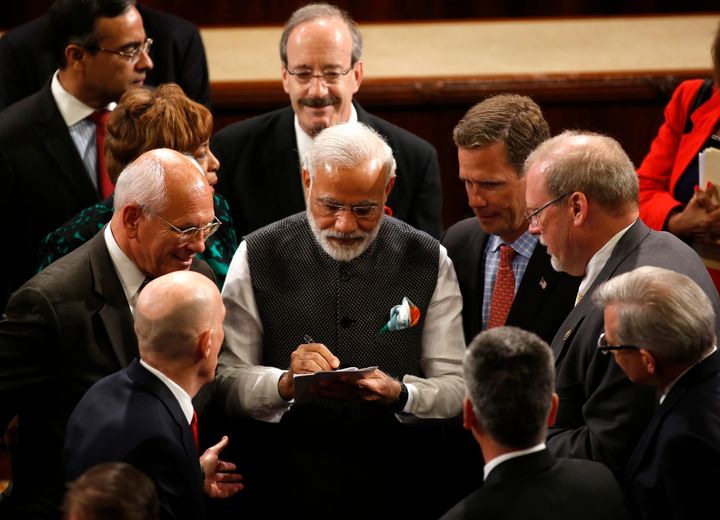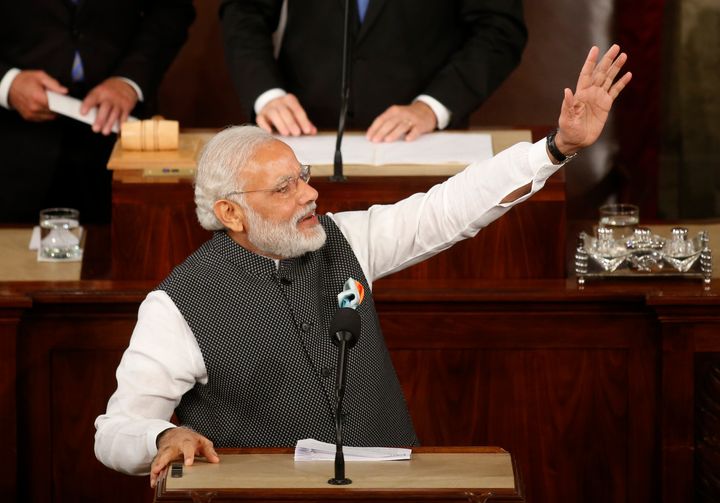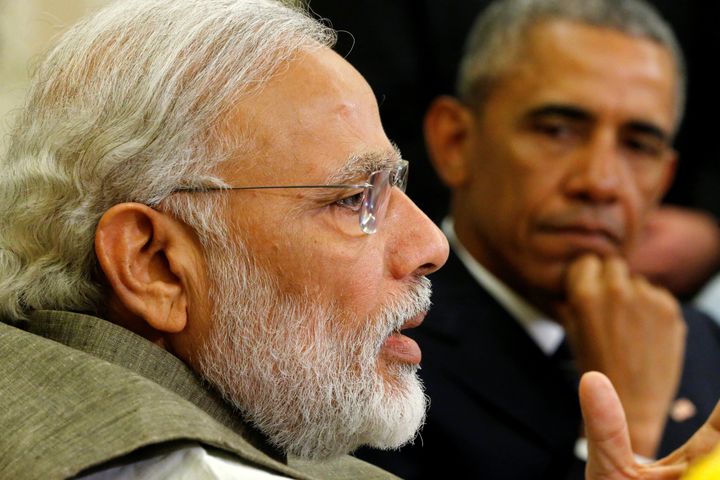
From Abraham Lincoln to Walt Whitman, from poking fun at the divisive politics of the US and Indian political classes, which he defined as “shared practices”, to pointing out that the American obsession with intellectual property rights did not extend to the ancient Indian system of yoga, prime minister Narendra Modi was feted by the US House of Congress on June 8 with eight standing ovations and much self-deprecatory laughter.
Modi is the fifth Indian prime minister to address a joint session of US lawmakers (sixth if you include Nehru, who addressed the House and Senate separately in 1949), and from the packed audience it seemed as if they had momentarily put aside the intensely riveting politics around the California primary and the subsequently presumptive nomination of Hillary Clinton as the Democratic candidate, to come and hear Modi in Washington DC.
By now, the man from Gujarat is clearly a pastmaster at the teleprompter. It is also totally irrelevant that he speaks in a Gujarat/Hindi accent. In fact, in this “land of the free and the home of the brave,” another American aphorism with which Modi brought the House down, the nondescript origins of Narendradas Damodardas Modi and his consequent rise and rise are treated with unusual interest. Especially when the opposition in India shows few signs of attempting to pick itself up and give Modi a good fight.
By now, the man from Gujarat is clearly a pastmaster at the teleprompter. It is also totally irrelevant that he speaks in a Gujarat/Hindi accent.
Here are the five takeaways from Modi’s speech:
1. The American treatment of prime minister Narendra Modi as a pariah because of his alleged role in the Gujarat riots of 2002 in which about a 1000 Muslims were killed, is a thing of the past. The Americans have decided that debates about tolerance and democracy and free speech and the right to eat any kind of meat must belong to the stratosphere inside India. The US is not going to lecture India anymore, and they are certainly not going to lecture Modi.
The Americans are pragmatists and they need India for a variety of reasons. This includes the hope that India will join the so-called “containment” of an increasingly powerful China by an increasingly nervous US. They also want India to join the US effort to put Afghanistan back on its feet. Moreover, frustrated by the Pakistani establishment’s decision to undercut America’s initiatives against the Taliban, the US is coming round to agreeing with India’s description of Pakistan being the “epicentre of terrorism” around the world.
Weakened from its years of war in Afghanistan-Pakistan but unwilling to give up its role of being the world’s primary power, the US believes that India -- certainly the world’s largest and noisiest democracy -- is perhaps the only other country that can assist them in these theatres of action in Asia.

(Prime Minister Narendra Modi (C) signs autographs after addressing a joint meeting of Congress in the House Chamber on Capitol Hill in Washington, U.S., June 8, 2016. REUTERS/Carlos Barria)
2. Prime Minister Modi is equally pragmatic. When the US reissued his visa to visit the US in 2014 as prime minister -- abandoning its own 2005 policy which cancelled his visa because of Modi’s alleged role in the Gujarat 2002 riots -- there were many Indians who suggested that the PM “not go” to the US because of the insults and humiliation the US had meted out to him. But Modi chose to ignore that advice and went ahead.
He has since met Barack Obama seven times. He calls him by his first name, Barack, like the other leaders of nations considered allies as well as non-NATO allies.
Two years later, that pragmatic policy has paid off. In the midst of a global slowdown, US business may be finally turning to look at India. Amazon founder Jeff Bezos announced his decision to invest $3 billion more into India soon after he met Modi in Washington DC along with 22 other CEOs, as well as separately.

(Prime Minister Narendra Modi acknowledges applause as he arrives to address a joint meeting of Congress in the House Chamber on Capitol Hill in Washington, U.S., June 8, 2016. REUTERS/Carlos Barria)
3. Modi has made India a closer partner of America -- although even he stopped short of using the problematic word, “ally” -- than any other prime minister since independence. “We will walk shoulder to shoulder together,” Modi told US President Barack Obama when he met him on June 8, and his speech at the Congress was littered with words like “connectivity,” “cooperation,” “shared practices,” and of course, “partnership.” Here is a key line from his speech:
“A strong India-U.S. partnership can anchor peace, prosperity and stability from Asia to Africa and from Indian Ocean to the Pacific. It can also help ensure security of the sea lanes of commerce and freedom of navigation on seas.”
So even though India is still not a US ally, unlike NATO allies such as the UK and Turkey, or non-NATO allies such as Australia and Japan, it looks like it is becoming America’s preferred partner in Asia.

(Prime Minister Narendra Modi (L) delivers remarks to reporters after meeting with U.S. President Barack Obama (R) in the Oval Office at the White House in Washington, U.S. June 7, 2016. REUTERS/Jonathan Ernst)
4. The prime minister’s trip to the US was certainly about saying farewell to Barack Obama, but equally to tell the bipartisan US Congress that he is willing to deal with whoever becomes the next president of the US, Hillary Clinton or Donald Trump. No wonder he was aiming to please the Congress, especially sections who wonder about his democratic credentials. Modi’s invocation that the “Constitution is his only holy book,” is aimed at reassuring this section of the US political class.
But the fact is that Modi’s democratic grandstanding abroad doesn’t cut much ice at home. In these very days, his own junior minister Sanjeev Balyan was making threatening speeches about the Muslim community in Bisara village in Dadri, saying they must be punished for eating beef. While Sadhvi Prachi, the female nun who promotes the RSS school, openly talked about not only making India a “Congress-mukt Bharat” (Congress-free India) but also a “Muslim-mukt Bharat” (Muslim-free India).
For Modi to become an effective statesman, he must pay the same attention to notions of equality and egalitarianism at home as well as abroad.

(U.S. President Barack Obama (2nd R) pauses for translation during remarks to reporters after meeting with India's Prime Minister Narendra Modi (2nd L) in the Oval Office at the White House in Washington, U.S. June 7, 2016. REUTERS/Jonathan Ernst)
5. Modi, simply, cannot refrain from taking a dig at his political opponents inside India, even when he is abroad. In his speech at the US Congress, he joked that he is the target of partisan politics, especially in the Upper House of Parliament, the Rajya Sabha, just like the “bipartisan spirit” that prevailed in the US Congress.
While that evoked a mighty laugh from his American audience, the fact is that Modi was behaving as if Indian politics began with his tenure in May 2014. He invoked former BJP prime minister Atal Behari Vajpayee in his description of India-US ties as being those of “natural allies” -- as well as repeated references to Swami Vivekananda’s speech in Chicago, an old RSS icon, and Bhimrao Ambedkar’s studies in Colombia University, a recent RSS icon -- but completely ignored the former Congress prime minister Manmohan Singh’s contributions to both India and the bilateral relationship with the US.

(U.S. President Barack Obama (R) shakes hands with India's Prime Minister Narendra Modi after their remarks to reporters following a meeting in the Oval Office at the White House in Washington, U.S. June 7, 2016. REUTERS/Jonathan Ernst)
Modi forgot that if it wasn’t for Dr Singh, he wouldn’t be standing here. That it was the good Doctor who bent backwards to applaud former US president George Bush’s policies (going as far as to say, “India loves you, President Bush”) so that he would look kindly at India and lean on the rest of the world -- including China -- to give India a waiver at the IAEA in 2008 and sign the Indo-US nuclear deal.
If Dr Singh hadn’t done what he did at the time, Modi wouldn’t have been able to announce India’s willingness to buy six US nuclear power plants during his visit to the US.
Modi wants the US to lean to China again, to get India a consensus at the Nuclear Suppliers Group. The Americans seem to be willing to do so – again. But Modi must understand that foreign policy is above politics. That’s how it used to be in the good, old days. As prime minister, he has the responsibility of returning India to that position.